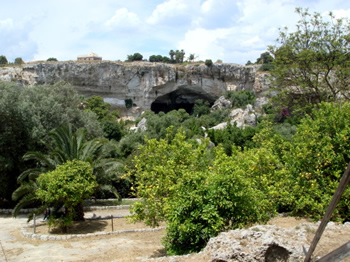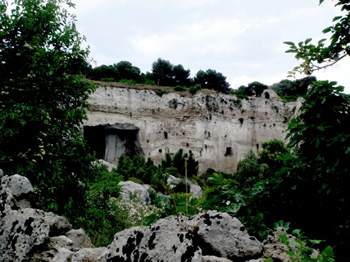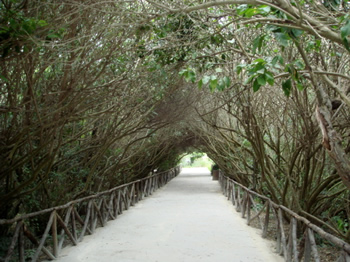
"Latomìe": the Ancient Greek Quarries of Syracuse
The famous "Latomie"
of Syracuse are none other than the stone quarries excavated,
since the Greek era, to meet the needs of stone to build the metropolis
of Syracuse (for which it is estimated that nearly five million cubic meters
was extracted).
 |
| The area of quarries as seen from the access road to the Archaeological Park. |
Since the layers near the surface can be of lower quality owing to water infiltration, the ancient miners preferred to extract deeper layers of rock, leaving those at the top in place.
Immense caves were thus created, many of which over the centuries have collapsed because of earthquakes, expanding the area available and usable as a garden.
For example, the huge pillar that stands
isolated in the quarries of the Archaeological
Park at one time held up a cave, now collapsed. As a result,
an area of dark caves has become over the centuries an open and verdant
place.
The lush garden that covers the ground
in front of the quarries, full of local and exotic plant species, offers
a splendid walk through the greenery, which is particularly pleasant in
spring and summer.
A good many of the 12 Syracusan quarries are now included within the Archaeological Park; of the others, only the Latomia dei Cappuccini (which is also one of the most atmospheric) is open for visits.
Orecchio di Dionisio (The Ear of Dionysus)
(See
the dedicated page)
Latomia dei Cappuccini (The Quarry of
the Capuchins)
(See
the dedicated page)
Latomia dei Cordari, Latomia del Paradiso,
Latomia dell'Intagliatella, Latomia di Santa Venera, Latomia Broggi, Latomia
del Casale.
 |
 |
| The area of quarries in the Archaeological Park in Syracuse. | A tunnel of trees in the garden of the quarries in the Archeological Park of Syracuse. |
All the quarries of the Archaeological
Park, with the exception of the “Ear
of Dionysius", are usually closed to visits, both for lack of personnel
and for danger of collapse.
However, ask for more information at the
ticket office before entering.
How to Reach the Quarries of Siracusa
from the Algilà
Ortigia Charme Hotel.
The quarries of Syracuse belong to the
Archaeological
Park, which is located off the island of Ortigia,
specifically in the extreme north of the ancient city (Neàpolis).
A route on foot is possible, although it exceeds a kilometer
/ 0.62 miles in distance.
Those who do not have their own transportation can call a taxi from the reception desk at a special rate or use the bicycles that the Hotel Algilà offers to its guests for free.
Alternatively, one can take the (free)
shuttle bus #20 from the nearby Piazza
Archimede up to the bus station (near the train station) and
then take either one of the following bus lines: 6, 8, 11, 12 or
13.
Otherwise, from Riva Nazario Sauro (behind
the nearby Piazza delle Poste) one can choose from the following bus lines
1, 2, 3, 4 or 12.
Visitor Information.
All of the sights within the Archaeological
Park can be visited with a single ticket of entry (full price € 6,
with reduced-priced tickets available for those aged 18 to 25 years and
free entry for citizens of the European Union under 18 or over 65).
Remember not to throw away the ticket
to go from one area to another.
Admission is free for people with disabilities
and for those who accompany them.
Unfortunately, the chronic shortage of staff requires the closing in turn of some parts of the archaeological area, depending on the day (one can ask about the situation at the ticket office prior to entering). The partial closure of the area does not result in discounts on the cost of the ticket.
The park is open every day, including holidays, from 9:00 a.m. until two hours before sunset.
Because of the enormous quantity of sights worth visiting and the extensive size of the area, one should plan to spend at least an hour and a half for a leisurely visit.
The area is free of architectural barriers and is accessible through a convenient road, which is easy to follow even for those who have difficulty walking (here a "problem" may arise only because of the extensive size of the area itself).
Back to TOURISM IN SYRACUSE, SICILY